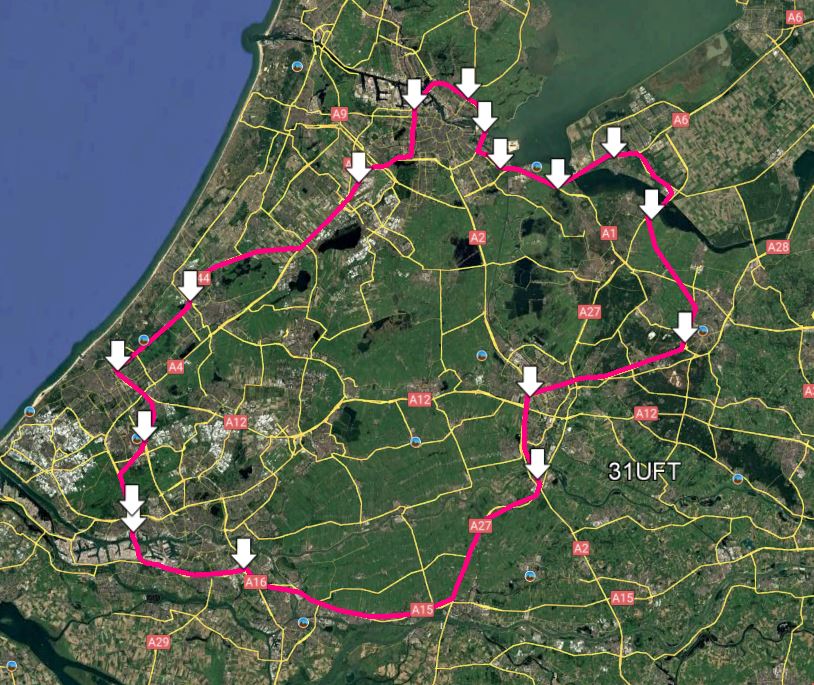So here is the virtual/imaginary me doing a seemingly absurd TED talk. Yeah I wish I looked like this.
How We Became a Civilization That Would Rather Choke Than Build
There was a time when The Netherlands dared to reshape the Earth. We diverted rivers, drained inland seas, and carved entire cities into the rock. We built cathedrals that required a century of work because we believed they were worth it. We reclaimed the Zuiderzee. Europe built the Channel Tunnel. The TGV. The Øresund Bridge. The Delta Works. Big, expensive, beautiful acts of defiance against natural limits.
Today, those instincts are gone.
Europe and The Netherlands are in the grip of a kind of psychological paralysis, a deep, ambient allergy to any idea too large, too new, too risky, too expensive—or worst of all, too effective. We are not lacking in engineers. We are not short of money. We are lacking in permission. In courage. In the willingness to be wrong—or right.
We are a civilization that will spend €10 billion over ten years on “strategy frameworks,” “resilience planning,” or “carbon offset metrics”—but will scream bloody murder if someone proposes to actually build something that might solve the problem instead.
Let me give you a very specific, very real example: the Netherloop.
A Tunnel. A Loop. A Civilization Hack.
The Netherloop is a proposal to construct a 250-kilometer underground loop encircling the Randstad—Amsterdam, Utrecht, Rotterdam, The Hague—with:
-
An 8-lane subterranean highway, 50–60 meters deep
-
A parallel high-speed electric train system
-
20 integrated “sunken city hubs” built into open-air atriums
-
No tolls, no land seizures, no displacement
-
Entirely privately financed
-
And zero public cost
How? By selling the surface.
The Trick Is Simple: Roads Are Real Estate
Every kilometer of above-ground highway is wasted land—a strip of dead tarmac, 40 meters wide, slicing through our most valuable urban zones. The Randstad has thousands of hectares of asphalted obscenity. It’s loud, toxic, and permanently unusable for housing or commerce. But if you put the road underground—fully filtered, insulated, and invisible—you liberate the surface.
That liberated land is not theoretical. It is monetizable. Immediately.
-
250 km of surface roads × 40 meters = 10 million m² of land.
-
Assume 60% usable for development (conservatively): 6 million m²
-
Current urban land value in NL: €3,000–5,000 per m²
-
Total surface real estate value: €18B–€30B
And that’s without touching the 20 underground hubs.
Each of these “sunken cities”—architectural atriums —offers 2–3 million square meters of mixed-use space. Built around natural light shafts. Flood-secure. Fire-proof. Designed for mid-rise housing, parks, vertical farms, logistics hubs, and commercial real estate. Together, they create up to 45 million m² of additional urban floor space, with values exceeding €200B over 30 years.
The Numbers That Change Everything
| Component | Estimate (EUR) |
|---|---|
| Tunnel construction (road) | €250m/km × 250 km = €62.5B |
| High-speed rail tunnel | €150m/km × 250 km = €37.5B |
| Urban hubs (20) | €2B each = €40B |
| Support, air, logistics | €10–15B |
| Total cost | €150–155 billion |
Now compare that to:
| Revenue Stream | Estimate (EUR) |
|---|---|
| Surface land redevelopment (6M m²) | €24B |
| Urban hub development (45M m² @ ~€5k/m²) | €225B gross / €90B net |
| Subterranean parking/logistics (250k spots) | €10–15B |
| Total revenue | €124–129 billion |
Yes—this covers most of the cost. The remainder is closeable via phased roll-out, bond financing, public-private consortiums, and EU climate resilience instruments. The break-even occurs within two decades. Long before that, it begins paying back in congestion relief, land value, freight efficiency, and public health.
The Congestion Crisis
The Randstad is dying of traffic.
Commutes stretch 90 minutes. Truck logistics slow to a crawl. Noise pollution, stress, and road rage are normalized. Every hour spent in congestion is a tax on productivity, paid not in euros, but in national economic stagnation.
The Netherloop would absorb 20–30% of Randstad traffic by shifting it underground, off the grid. You don’t need to eliminate cars. You need to get them out of the way.
The NO₂ Crisis
According to RIVM data, Dutch road transport produces ~40,000 tons of NO₂ annually. The health impacts are severe: heart disease, asthma, cancer, strokes. Traffic corridors are invisible poisons through our cities.
If the Netherloop redirects 30% of vehicle kilometers traveled, and filters all emissions through ventilation and capture systems, it could remove:
-
12,000 tons of NO₂ per year
-
~30% of all traffic NO₂ in the Netherlands
That’s an immediate, measurable impact on public health. No carbon credit accounting. Just cleaner lungs.
The Housing Crisis
The Netherlands needs 900,000 homes by 2030. Everyone knows this. No one knows where to put them.
The Netherloop literally manufactures space—millions of m² from thin air (or rather, from beneath the ground). You’re not invading farmland. You’re not cutting into forests. You’re reclaiming tarmac and vertical depth.
The 20 urban hubs alone could house half a million people, in walkable, car-free neighborhoods directly connected to high-speed transit.
Why We Won’t Do It
We do this because we for some reason terms these concepts a priori “absurd”, or “unaffordable”. As a culture we have become actively disinhibitied from anything that plausibly might be regarded as too disruptive or uncertain. Because the permit process for 20 years of housing units is harder than tunneling through Pleistocene clay.
Because The Netherlands has trained itself to fear imagination and worship incrementalism. Because every time someone proposes a bold solution, 14 committees are formed, 9 impact studies are commissioned, and the idea is filed away.
Until climate collapse. Until housing implosion. Until congestion makes the Randstad unliveable.
We are not short on tools. We are short on nerve.
Final Thought
Europe doesn’t need to be America. It doesn’t need Silicon Valley hype. It doesn’t need ego-driven vanity projects.
But The Netherlands needs something.
Something bigger than another think tank.
Something real.
If we can’t build a tunnel under our own cities and pay for it with the very space it unlocks, what exactly can we build anymore?
Yes, yhe Netherloop is a grotesque idea.
Right up until the moment you run the numbers.
Then it becomes obvious.
And devastatingly overdue.

